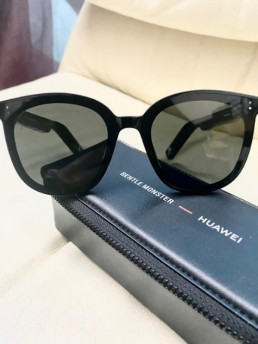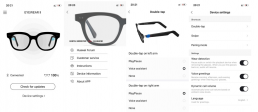The brand-new Huawei X Gentle Monster Eyewear II smart wearable, following its predecessor’s debut in 2019, has finally arrived. Made with titanium plastic and coated with high-gloss finish, the sunglasses weigh about 44g and come in four styles with customisable commands on their featured app available on both iOS and Android.
The glasses feature a stylish accessible haptic and voice framework, as well as upgraded audio quality, and they are priced at £310/€345.99 (Huawei UK’s online shop is offering a £50 off promotion at the time of writing).
Design and Control
When I received the glasses, they came in a beautiful faux leather box. Inside, there were the Smart MYMA glasses along with a type-C charger and a manual. First, I downloaded the “Eyewear” iOS app (“AI Life” on Android), then I connected the glasses to my phone via Bluetooth and then checked out the haptic gestures on the mobile app.
The audio technology is reasonably intuitive, with just two gestures (wipe and double-tap) and four functionalities (adjust volume and previous/next, voice assistant and play/pause). The touch sensitivity is good, and I was able to make adjustments without a problem.
The sound quality compared with my ENAC Fire truly wireless earbuds was slightly disappointing, especially when the volume was enhanced for a more dimensional audio experience. It seemed to me that sound leakage from the rim is a common issue around the temples. Unlike bone conduction, where sound transmission is conducted through facial bones, the volume from the eyewear is so high that anyone nearby — in your room, at a café or while travelling — will be able to hear the content. Especially when you’re on a private call, a pair of truly wireless earbuds such as the Freebuds 3i may be a better option.
That said, the glasses are smart enough to pause the sound automatically when it detects gravitational variation (when removing them, for example), which reduces movement. Most importantly, they’re almost indistinguishable from a regular pair of sunglasses. So, if you want to listen to music in disguise while blocking UV light from the sun, these are a good option.
Battery Life
Battery life is a key issue for many technology companies, due to its durability and convenience. Huawei has adopted NFC fast-charging technology, which took just over an hour to charge to full.
I played music for an hour while wearing the glasses and, given that I’m not an audiophile, I thought the technology was easy to master and the audio quality was acceptable, with a chic exterior design. I kept the music playing with the glasses on my desk to test out the battery life, and that lasted for another four hours.
It was fun to try out this niche glass category, particularly when it’s still in its infancy, and I’m excited to see how the technology develops.
Limitations
Nonetheless, Huawei’s Gentle Monster Eyewear II glasses are not widely popular yet, and there are definitely a few things it needs to improve to make it more competitive. For me, the glasses felt very bulky when I was wearing them. They have a one-size-fits-all glass frame and when I moved around they kept slipping down the bridge of my nose. Also, the charging case is not a battery on its own, so you have to connect the box to the power supply, which makes it less mobile than a portable wireless charging earbuds case.
In addition, the price point is way above its pioneer smart eyewear competitor, Bose, and its Frames Soprano audio sunglasses (£239.95/€279.95). Huawei is clearly positioning itself at the high end and is marketing its products as classy fashion accessories, aimed at fashion influencers and technology enthusiasts.
Verdict
The Gentle Monster Eyewear II glasses are a bold statement that reflects Huawei’s ambitions in this market, expanding its ecosystem and technological advancement. That said, I think the company has chosen the wrong time to launch the glasses (in the fourth quarter of 2020). Consumers were not ready to spend a ton of money on unfamiliar non-essential electronic goods during a global health crisis, at a time when their level of disposable income was limited due to the holiday season and with many discounts available across other categories.
Although personally they do not fit my lifestyle and face, the glasses have a lot to offer to consumers. With some thoughtful adaptations and features, I believe they could lead this category.
If you want to learn more about this topic or have any questions, please contact Kyla Kam, or head over to https://www.idc.com/eu and drop your details in the form on the top right.



